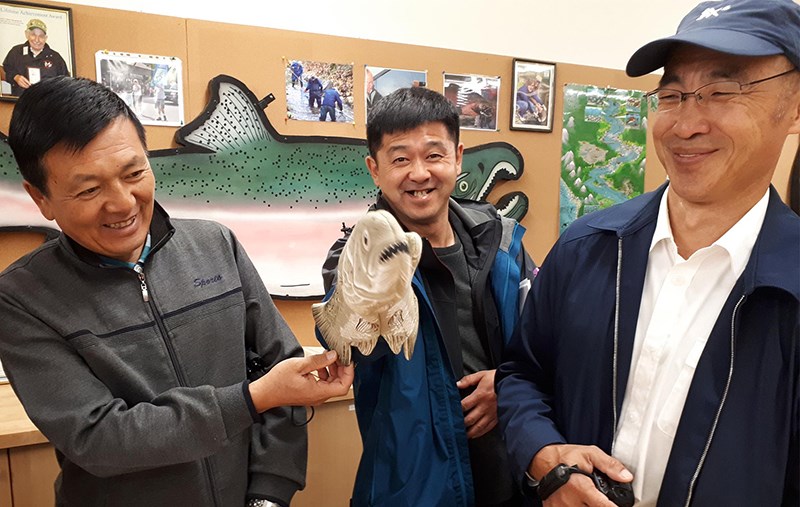Local fish hatcheries could be models for Chinese environmental groups seeking to restore salmon runs on one of the world’s largest rivers.
And with salmon set to return to spawn this fall, a cultural exchange and fact-finding mission that took place recently could herald a new form of relations between Canada and China that share a water body — the Pacific Ocean — and whose salmon species share similar traits, says retired biologist Matt Foy, who organized the tour.
“Chum salmon you see in Hyde Creek [in Port Coquitlam] look just like the ones you see in China,” Foy told The Tri-City News last week after he said goodbye to a delegation of three Chinese officials who spent several days in September touring Tri-City volunteer-run hatcheries and some of B.C.’s larger federal facilities.
The goal of the trip, according to Foy, was to find ways to boost chum salmon stocks on the Heilongjiang River through the establishment of small and medium sized hatcheries similar to those that have been so successful in B.C.
A large fish hatchery located at Fuyuan City already produces Pacific salmon as well as two types of sturgeon, according to Foy, but more could be done.
“The NGO is trying to get a handle on the salmon resources of China — what they think they had, what they think they have left and what they could do about it.They know a lot about fisheries but they don’t know about how the fish go to the spawning grounds,” Foy said.
The trip follows two visits by Foy and a colleague to Fuyuan County to tour hatcheries there and write a report for the Salmon Ecological Environment Protection Association, which was started by an entrepreneur interested in the environment.
He said the river, which shares a border with Russia, is the size of the Mississippi and issues faced there are similar to those facing B.C. rivers: overfishing and habitat destruction.
Foy, who worked on B.C. salmon restoration projects for 35 years with Fisheries and Oceans and Canada before retiring in 2015, says the success of local hatcheries to overcome those challenges through salmon restoration projects could be replicated on the Heilongjiang River.
While in the Tri-Cities, the delegates visited the Hyde Creek Education Centre and Hatchery in PoCo and a small hatchery on the Coquitlam River in the River Springs subdivision as well as Mossom Creek Hatchery in Port Moody, where volunteers have been raising chum, coho and pink salmon with the help of Centennial secondary students in the school’s fish and wildlife program.
Foy said B.C. hatcheries are blessed with volunteers who see salmon as more than a food fish and he hopes the Chinese delegates can inspire the same feelings back home.
“Salmon are the great unifier,” he said, noting that wild Pacific salmon are an iconic fish that have become important to British Columbians over the last several decades.
In China, Foy said, a similar metamorphosis will likely take place, inspired by individuals wanting to give back to their community in the form of environmental stewardship.
Making the leap from food to cultural symbol is an important step and he expects Chinese delegates will be successful once they tackle this key question:
“How do you move a fish from something on your plate to something more cultural — because if you can’t and you view every fish as dinner you won’t protect it.”
SALMON STORIES FOR KIDS
Want to know more about how environmental groups are trying to bring back Pacific salmon in China?
Matt Foy has written a children’s story about the effort in both English and Chinese that describes the efforts of restoring salmon in the Heilongjiang watershed and the life cycle of salmon through the eyes of Little Xin, a chum salmon, and others.
The story describes the watershed that is shared by China, Russia and Mongolia and was once the greatest chum salmon river in the world, with as many as 30 million salmon returning to the watershed each year.
Today, these chum salmon returns are about a third of what they were prior to the arrival of commercial fisheries beginning in the 20th century, and Foy, who wrote Black Dragon Salmon for elementary school children, hopes Chinese and Canadian students and parents will read the story and learn about these efforts.
“I am hoping [this book] would get across the idea of environmental stewardship very early.”
The book is available here. It’s one of several stories Foy has written about the Salmon People to mark the International Year of the Salmon in 2019.



